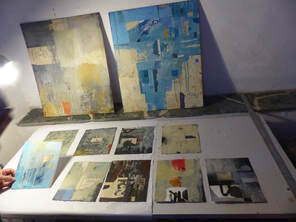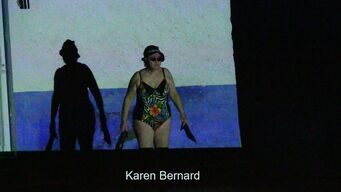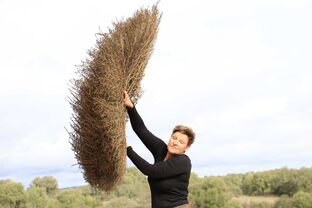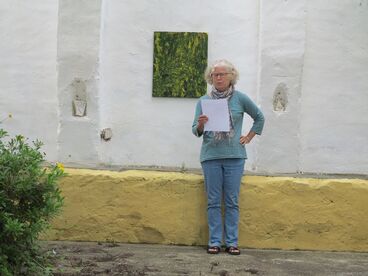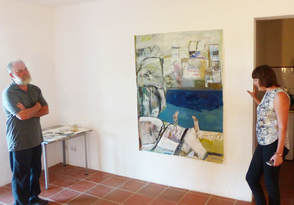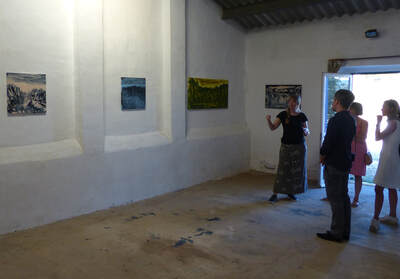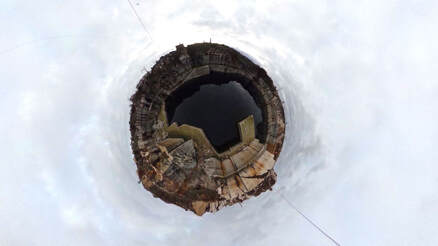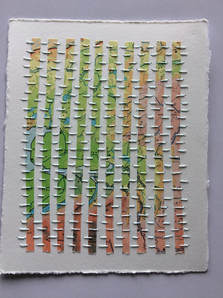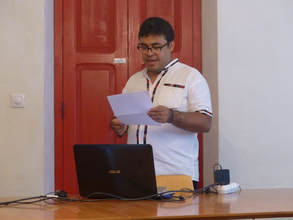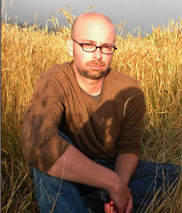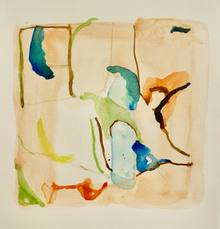This page shows residents and their projects in 2018.
Other pages show residents and their projects in 2017, 2016, 2015, 2014 , 2012 and 2013 and 2004-2011.
A visual collage of residents is in this slide show.
Other pages show residents and their projects in 2017, 2016, 2015, 2014 , 2012 and 2013 and 2004-2011.
A visual collage of residents is in this slide show.
|
Kevin Tolman (USA) was making collages with snips of Portuguese journals. He had a very productive time, both in terms of quality and quantity. Kevin Tolman has a strong relation with Portugal, or more precisely: with the layering of periods that can be seen on walls, billboards and ruins. His artwork is clearly showing this fascination.
Sarah Tolman (USA) made a beautiful series of prints, partly on journal pages and partly on a background of blue-white tiles. In all a beetle a grasshopper and an ant are figuring, either alone or in combination. In many cases the images suggest to tell a story or a joke.
For the first time in her life, Annelisa Leinbach (USA, living in Berlin) got the opportunity to create a wall-sized oil painting of nearly six meters long. Quite a challenge as it needs other composition and brush strokes compared to smaller sizes. But she loved it and created an amazing piece. The piece was part of a series about sexual assault as interpreted through the myth of Apollo and Daphne, where a woman is turned into a tree as she prays to the gods for salvation from her attempted rapist. Annelisa re-imagined scenes from this myth in the modern day.
Karen Bernard (a New York based dancer/performer/choreographer) did a performance in her swimsuit outside at night while it was exceptionally cold and windy. But it was not just her braveness to resist the conditions, but even more the content that moved the audience. As a dancer facing physical limitations, she made aging the subject. She made a beautiful statement: “I access known styles of dance and retro music to infuse them into a personalized form of expression to trigger physical and emotional engagement of memories, aging, loss, the present and future. During this residency I have focused on creating a video where the editing has a rhythm that becomes the dance. Choosing the location of the Circular Square became very exciting for me, as the mundane became extraordinary.
In April 2019 Karin had a nice interview in Movement Research (click here to read). The article tells about Poolside, a work that she largely created during her residency and that she later converted into a multimedia installation that was shown in February in Chashama, New York. In the interview Karen tells about the content of Poolside, the making of and her vision on the career of a dancer. Stella Whalley (UK) was deeply shocked by the Grenfell disaster, a fire in a tower block building (London, June 2017), in which 72 people died, mainly due to inadequate fire prevention by the construction company. And she was frustrated by the authorities showing little compassion with the victims. The disaster by itself and the broader concept of a world in which this can happen brought her to the installation “I'm tired of….”. This installation consisted of seven paper hangings ranging in height from 2 to 5 meters, worked in mixed media on both sides, using painting, printing and stencilling processes totalling 14 images. She used her body to print creatures that seem like falling angels, and added other print layers with grids, textiles and texts. Stella made an artist statement on this work:
“The ‘I’m tired of….’ installation has my deep feelings on the Grenfell tragedy as a starting point. I want the audience to look up to these tall pieces seeing figures falling. The prints of curtains and clothes and graphite paint refer to the victims. The printed texts express my anger, the hand written texts are the words of the victims. With a final layer of printed building materials I suggest a space where they were trapped between looking out on to the world and looking into a vanishing private world. My contemplation on Grenfell brought me to more general feelings on injustice both in the wider world and in my personal life.” Miguel Noya (Venezuela) added a sound composition to the installation.
Inspired by the “I´m tired of …” rantings, suggesting both blaming, frustration and disillusion, he created a mix of sounds with a pitch gradually building up. For this composition he used local sounds from a marble cutter, a church choir and sheep bells. Look at and listen to a video impression of the installation. In her two-months residency she made another installation, experimented with herself in nature covered with a white tissue, and did trials with whitened flowers and transparent marble: see slideshow. Victoria Cattoni (Australia) returned for the fifth time. Her body of work of this residency was very consistent with earlier years: dreamy abstract oil paintings in subtle rose and purple colors, with one exception: she worked on a 2x1.5 m canvas, bigger then she every used. In her artist talk showed a different part of her work: videos on trans-culturality and gender. The videos showed her personal observations and experiences: she lived half of her life in Japan, Indonesia and Singapore.
After his visit to the marble quarries the American painter Paul Gagner knew what to paint. He painted, among others, a series with a background that suggests to be a marble tableau and a text that seem to be chiselled in the marble. The texts were ordinary, humoristic or scabrous. The combination of classical, pompous background with a vulgar text was effective and intriguing. Paul had a wonderful presentation of his work in the patio. The slideshow gives an impression.
Nico Huijbregts (Holland) had a two-months residency. He was composing an elegy for a male choir. And he made hundred (!) improvisations on piano, ranging from 30 seconds to 10 minutes; each day minimum one and each of them totally different: contemplative, wild, easy listening, atonal, … They can be heard on his Facebook site. It reminds to his project of 2014 when each day he put his chair with the back to the house, made a drawing and a description of what he saw and put his chair two meters further on for the drawing of next day.
Becky Buchanan (UK) used acrylic paint on plastic PVC canvas to make an impressive series of ten 1.30x1.30m works and some smaller ones. Starting with no plan and working largely intuitively she made abstract, colorful paintings that seem to express energy and optimism. Although the viewer thinks to recognize suggestions for a concrete object or a meaning, for Becky the major goal is to find a proper balance in composition and color.
Becky made a beautiful video clip that shows some of her Portuguese works and her sources of inspiration. They were exhibited in August in Centrespace Art Gallery in Bristol under title: Abstract Artfulness - Perceptions of Portugal. And later her painting ‘Perceptions of Portugal’ was selected for an exhibit in the famous Royal Academy in Bristol, UK (October - November 2018). Becky started every day around 7am and seemed to have infinitive sources of energy. Apart from many hours of painting, she had time and energy for nature walks, jogging, swimming, Ping-Pong and piano playing. Julie Keating (Australia) fascinated by the street of her residence. She collected information on its recent history through literature and talks with neighbors. A century ago a nearby house was home for several famous landscape painters another was a sanatorium for children with tuberculosis.
Another study object of Debby was the nearby woodland (“a pleasure park and a place for fairy tales rather than the frightening forests of Australia”). She made hundreds of drawings and small paintings. Her still lives and landscapes were also color studies, she especially analyzed the greens and blues of vegetation and skies. Rob Monaghan (Ireland) came back to complete his project on the marble quarry lakes. He went in the night at fool moon to make underwater photos in these lakes for blob art, a highly ambitious project initiated by Mirjam Slaats. They started their collaboration during their residency last year and developed it with a month-long orientation in Abu Dhabi. Last year the fishes came to Rob while he was swimming, but not this year, may because it was spawning time.
This bad luck was more than compensated by a new collaboration: he made a video project together with Phyllis Olwande (see below) who performed deep down in an abandoned marble quarry. Standing on the edge of a ravine or until her knees in the water, she danced using a mix of flamenco, butoh, yoga and own inventions. A video of the work was exhibited in August as a multi-screen video installation in an intimate open space in a forest as part of the West Cork Arts Festival (Ireland). The installation was made together with Tom McCarthy (sound artist). The work is also on the shortlist for the Loop video art festival in November in Barcelona. Currently, Phyllis Akinyi lives in Denmark, but she strongly feels her Kenyan roots. Educated as dancer and specialized in flamenco, she recently realized that this may be a too narrow base for her future. She used her residency to experiment with cross-art and site-specific performance. She had collaborations with Linda Buckmaster (poet) and Ingrid Simons (painter). But especially the project together with Rob Monaghan (video-artist) brought spectacular results. Deep down in an abandoned marble quarry, standing on the edge of a ravine or until her knees in the water, she performed using a mix of flamenco, butoh, yoga and own inventions.
In May we had two exhibitions: of Gaelle Pelachaud and of Andrea Brasch (see the three slide shows below for an impression).
Gaëlle Pelachaud (France) had an exhibition: ÁUREAS (Reflexoes duma Segonha), in the INATEL building in the Centre of Évora. It ran until 30 May 2018. During her artistic residencies in 2016 and 2017, Gaëlle made hundreds of drawings of storks, especially of the storks nest at the abandoned railway station of Evoramonte. She showed several these drawings, partly in the form of artistic installations: a scale model of a stork´s nest on a pole and a drawing of the floor that shows the landscape in a birds eye view were part of the show.
Gaëlle Pelachaud creates artist books. For Áureas she found a collaboration with a bookbinder from Evoramonte: João Ruas. In this artist book several poems by Maria Sarmento are presented. Maria Sarmento (Evora) wrote a series of poems inspired by the work of Gaëlle Pelachaud. The poems are in Portuguese with a translation in French. Gaëlle also established a collaboration with Matthew Manowski (USA). He had a very productive residency in September 2017, with an obvious highlight being his “sound installation performance” in the fortress of Evoramonte on the occasion of the opening of Diaspora, the exhibition of Kevin Morrow. During his residency in 2017 he met Gaëlle Pelachaud, who invited him to contribute with a sound installation to her exhibition this year. Matthew collected sounds from nature, partly manipulated them and composed a serene sound piece that beautifully combined with the visual parts of the exhibition. Andrea Brasch (Denmark, currently living in Berlin) had an exhibition: Cartas de Amor, also until 30 May 2018 in the INATEL building in Évora. Andrea has a specialty in digital storytelling and game design. During her residencies in 2015, 2016 and 2107 at OBRAS she worked on a project about an envelope that she got from her grandparents with their instruction to open it only after their decease. She came to Portugal to open the envelope on an inspiring place. It contained letters that her grandparents wrote to each other in the first years of the 2nd world war.
Andrea made a multi-media presentation that included a collage of postcards and text fragments that she found in the envelope, a video that showed her opening the envelope and a virtual reality piece with which the visitor of the exhibition could experience the impressions that Andrea had when she was a little child looking to the big world from under the kitchen table of her grandparents. All visitors adored the VR piece. At the simultaneous opening of the exhibitions of Gaëlle and Andrea Andreia Fernandez (Portugal) gave a wonderful short violin concert. One of her pieces was her own composition.
Marijke Schurink (Holland) made intimate, small installations with found objects and experimented with light-sensitive paper. She used the forms of portraits, Portuguese tiles and necklaces as a base and combined it with natural elements, marble chips and yarn.
In addition, Theo and Marijke made videos of Theo picking acorns and of Marijke Schurink dancing with a huge bush.Their works were presented at the end of their residency on 6 January (Three-Kings-day). We invited around 30 friends and it became a memorable event due to their beautiful exhibitions, but also because of a small concert by Mauro Dilema (piano), Andreia Vaz (violin) and Eva Pelgröm (violin), the very good food and wine and the friendly atmosphere. Have a look at the slideshow for an impression of the works of Theo and Marijke, and of the party. Linda Buckmaster (poet; USA) created many poems, partly in collaboration with other residents. She wrote a poem on a painting of Ingrid Simons, telling about what she experiences when going inside the picture. At a local poetry festival in the castle of Evoramonte she read a poem while Phyllis Akinyi did an improvisational dance following the rhythm of Linda´s words.
Linda also read an ode on OBRAS, standing in the field with sheep in her background and their bells as background sound. |
Yvonne Halfens (Holland) had an exhibition of her ceramic work in the fortress of Evoramonte. The slide show on this page gives an impression.
Yvonne made a beautiful statement for this exhibition: My portraits do not refer to a concrete person, but to his reflections on human being. I created this exhibition after a few experiences in Portugal. Recently I saw in Évora an old wooden statue of a saint, with an unknown creator. The statue was beautiful, but the woodworm had made it a masterpiece. The decay and the imperfection gave it history and extra quality. Many Portuguese churches have statues of saints, consisting only of a head and chest on a wooden frame where the dress had been draped around. Somehow shocking to know that so much holiness is based on a few wooden slats. But it is also so much more human than it seems. When you read the classical philosophers, it is surprisingly clear that nothing has changed in our psyche. My portraits in this exhibition are often forgotten people are often forgotten people, sometimes eroded by time. But also earthy, timeless, ordinary and unique, just like us. Helen Butler (UK) creates meditative, abstract paintings, inspired by atmospheric colour and light. At OBRAS she made a series that she called “bliss of Silence”. Helen contemplated on the relation between the colours in the sky during the evening twilight and her own internal landscapes and sense of being.
Morgan Adler (USA) had a residency at OBRAS-Holland. She loved the little town, the beautiful nature that surrounds it and her biking tours. She painted churches, field, animals, … and being just graduated from university she contemplated on her future. She started writing short essays on contemporary art.
About the body of work that Scott Wixon (USA) created during his residency in Portugal he stated: “I have created a series of small works on paper using watercolors and colored pencils. I think of these works as abstract landscapes which are influenced by my surroundings and draw on a vocabulary of shapes and forms that I have developed over the years. They are not planned out ahead of time but built from the starting shape. I strive to achieve a dynamic tension with the interplay of shapes and colors.”
In January 2019 Scott Wixon had an online exhibition at Phoenix Gallery (New York), most of them being his “Portuguese” works. Amee Evans Godwin (USA) came to work on a video that will be part of the musical theatre performance I am the size of what I on 6 October in Évora (see above). In addition she made drawings and small installations. Many of them were inspired by the sense of transiency that she experienced at her visits to an abandoned marble quarry and the ruins of a convent. Especially impressive were her anatomical drawings of muscles and bones on marble shatters that she combined with a text of Pessoa on a playing card.
Sabine Harrer (Austria, currently living in Germany) and Ida Toft (Denmark, currently living in Canada) came to work with vibropixels: a tiny electronic device that can be programmed to vibrate in various frequencies and intensities. Sabine and Ida are game designers and member of the Copenhagen Game Collective. At OBRAS they explored potential applications of vibropixels and tested them with some playful experiments, using the residents as guinea pigs. The experiments caused participants to contemplate on identity, individuality and uniqueness. Ida added another skill to her experience: marble sculpting. She chiselled holes in marble blocks, just big enough to receive a vibropixel, thereby creating an intriguing combination of fragile electronics fixed in a pompous piece of stone. Her vibropixel project will become part of her PhD thesis. Sabine had a side activity as well: playing the violin. She granted us several improvisations, partly in combination with other musicians.
White Works was the title for an exhibition with Phil Moody (USA) in the Palácio dos Marqueses da Praia e Montforte, in Estremoz. On the opening was a speech by Ruben Martins (prof Geoscience on Evora University) and a musical contribution by Daniel Catarino (guitar). The exhibition closed on 16 September. A beautiful catalogue is available at OBRAS and the artist.
Phil Moody came in 2014 and 2015 for making photo portraits of workers in the marble quarries. Very exceptional was that Phil got permission to make a photos of workers deep in a marble quarry of Estremoz. He printed eight 2x2m photos. To make them more than documentaries he fragmented each photo into 250 "tiles" and printed them on pages of old geology journals (dating from 1830 until 1950). This written information shines through the image. In addition he made a brochure where these images are combined with information on marble: the history, geology, economy and especially the life of the workers. He is especially interested in the stories of retired employees: they started when it was common to bring water to the workers with a donkey, they experienced the booming of the marble sector, but also the decline and the structural crisis of this sector. A beautiful co-incidence was that photos of the quarry in 1901 are in the archive of the municipal library. These were also included in the exhibition. The slideshow on this pages gives an impression of the works and the exhibition. Part of the exhibition is now touring in South Carolina (USA). This is the result of a statewide contest in which Phil gained the second price. Congrats, Phil! Phil started a collaboration with Luís Lopes and Ruben Martins of the GeoScience department of Évora University. He may produce a book together with them. In June, Julie Keating and Debby Hill had residencies at OBRAS Holland.
Debby Hill (Australia) was inspired by the urban and natural landscapes in the direct surroundings of her residency in Holland. She was intrigued by the forms of the trees (nature) and the old remnants of the industrial time of Renkum (man made chimneys). Her work was an investigation in relations in both time and space: the connection and disconnection between these natural and urban elements: 50 years ago the brick factories cleared the trees to mine the clay and now the ruins of these factories are overgrown by trees. Or more often they together have created a mysterious, often romantic scene with both man made and natural elements. Debby made drawings, in a sketchbook, but also on stonework and in antique books and music scores. In addition she made small ceramic objects. Sofia Malone (Sweden) came to study “stony landscapes” and found her subjects in the gigantic hubs of marble waste. She especially enjoyed the many colours in what is assumed to be white marble. She experimented with bringing fragile human figures in this robust, may be even hostile landscapes.
Dena Afrasaibi came with her parents from Iran to the USA when she was two years old. Because lived most of her life in an Iranian community in Austin, Texas she still strongly feels her Iranian roots. And this is the central item of the novel she was working on: the feeling that you have roots far away from where you live and work. Are we nomads in the global village exist? Is it necessary to make decisions in order to build a future? What is emotion and ratio?
Dena worked extremely dedicated and with a strict daily rhythm on her novel, but she also found time to make nature walks, which did her realise that she is more a country girl than she was aware of. And she rewrote a very funny short story about a group of people who decided to become a tree. She did read this story twice for different audiences and had a lot of success. Already for seven years Ingrid Simons (Holland) comes every year, because Portugal has a crucial and catalyzing impact on her work. She continued working on her half-abstract landscapes, partly marble quarries, partly at sunset or in moonlight. She paints in oil and works with only one or two colors. But step-wise and especially this year she added more. Several paintings became extremely powerful. In September-December Ingrid presented some of her recent Portuguese paintings in the highly prestigious Noordbrabants Museum .
Some years ago ceramics started as a side-activity for Ingrid, but it it became more important, especially since she found a very inspiring collaboration with Francisco Tarefa, a master potter from Redondo. Her latest achievements are large thick, slightly curved tiles that can stand free upright, making the tile a three-dimensional sculpture. With glazing and scratching Ingrid made abstract landscapes on them. Probably due to its form the viewer feels sucked into the image. Colleen Franca (USA) painted in an impressionistic stile a series of landscapes, townscapes and objects around the house, such as a bunch of puppies or the laundry line. They show her fascination of observing. Her attempts to catch light were both playful and highly professional.
Dario Argentesi (Italy) is a highly talented young composer and pianist. He rehearsed for a concert that in July in Italy and gave us the try-out. One of the pieces was the beautiful, 45-minutes Pictures at an Exhibition by Mussorgsky, for which Dario projected most of the paintings. Dario was also inspired by what he saw in his surroundings. The titles refer to that: “Evoramonte”, “pre-historic grave” and "cats”. On 5 and 16 May he gave piano recitals including a composition that he created inspired by Evoramonte and the surrounding nature. Watch this video .
Kate Sameworth (USA) made more than hundred miniature drawings, covering themes such as birds, mythical animals a (fictive) family tree. Each theme fitted perfectly in a small wooden or tin box. On the back of most were poetic, philosophic or humorist short statements. Due to the size, the boxes and the texts the work was surrealistic, intriguing and very intimate. The slide show gives an impression.
Grant Palliser (New Zealand) is bronze sculptor, but showed to be highly skilled in other disciplines as well. He sculpted a kind of chain the wood and bark of cork oak and called it stop-go. And he painted a lot. Some were inspired by the music of his fellow resident: Dario Argentesi. And not unimportant for all: he proofed to be a master cooker of cakes.
Bobby Esra Pertan is a Turkish filmmaker, currently living in Denmark. At OBRAS Portugal she was working on a project that describes part of her family history. Her family tree has branches and roots in Turkey, Russia, Bulgaria, Norway and Greece. In Istanbul her grandparents had a flourishing enterprise in a giant historical building overlooking the Bosporus. Bobby has lots of childhood memories of that place. The building is now abandoned and in a desolate state and is planned to be stripped and converted into a boutique hotel. Bobby made impressive videos and photos of traces of the past in that building and this will become an exhibition entitled Alas! (which is Turkish for “What a pity!”). The exhibition will tell a forgotten story but will also contemplate on the phenomenon of gentrification.
Alison Kruse (USA) had a residency at OBRAS Holland. She experimented with techniques for her oil painting, such as applying it very wet and separating oil form pigment. She worked on old and new themes such as still lives and the natural disasters of early 2018. But basically she was studying the human interference and the force of nature.
Theo van Delft (Holland) experimented with 360-degrees photography. For this he threw a wire over the lake of a marble quarry (50 meters; an amazing achievement by itself), hung his camera on that wire, guided it to mid above the lake and shoot by remote control. The result was a set of images that are surrealistic and abstract, alien and hallucinating and above all very beautiful. Part of the work was exhibited in September, October in Huis als Museum (Amersfoort, Holland).
|
Larry Feign (Hongkong) was working on The Pirate Queen: a novel based on a true, 19th century story about Shek Yang, a prostitute from Guangzhou, who was forced to marry a pirate’s captain. After his death she became the undisputed leader of the largest pirate fleet the world has ever seen. She defeated an international, partly Portuguese armada in one of the largest sea battles in history. Moreover, she established an iron-fisted peace along the South China coast and proclaimed a surprisingly feminist code of conduct for her pirates, all the while searching for peace in her own heart and a companion who wouldn’t betray her.
Natalie Magniez (France, currently living in Amsterdam) started a project: “The Space Between”. She explored the space between past, present and future, between the visible and unseen, between figuration and abstractions, between being a daughter and a mother. She contemplated on transiency, transmission and heritage. This resulted in two big colourful paintings, one figurative (portraying herself and her daughter) and one abstract (powerful and intriguing).
In January, Februry 2019 she exhibited her "Portuguese" works under the title Nature Intimes (MPTVA, Ville D´Avray, France). Carole Wilson (Australia; visual artist) had a residency at OBRAS-Holland. She added more works to her ongoing series “ Field Notes”, Among others she stitched strips of geographical maps on carton.
Also Annie Drum (Australia; writer) had a residency at OBRAS-Holland. She was working on her novel draft ‘What Shape the Wind’ and made a series of small installations of found objects such as bottle tops, part of a bicycle bell and a shopping list in German.
Dany Diaz Mejia (Honduras; currently living and working in San Salvador) is an emerging writer from the countryside of Honduras. He had a terrible, life changing experience that brought him to writing. A relative was found murdered after sadistic torture and it was his task to retrieve the body from the morgue. Writing proved to help him to overcome his trauma. Dany was directly rewarded for his first short stories. At OBRAS he was working on 13 short stories, all playing in rural life of Honduras. Although he uses the humor and irony of how people of his village talk and live, most of his stories are heavy in content and psychology. In his artist talk he read a story that he just finished: about a fire in a prison in 2012 that killed 359 prisoners, most of them waiting for their trial. The story tells about the guard responsible for the keys, did not dare to pass the keys to the prisoners for them to escape their cells. We were all impressed and shocked.
Wilma Geldof (Holland) came back to work on her second novel: about a boy who confesses that he murdered his mother (even although going the story this fact is gets less clear). A deeper layer of the novel is a contemplation on an unhealthy tight bond between mother and sun.
During her artist talk Wilma showed us with a nice group exercise how she teaches creative writing. Before coming to OBRAS, James Bell (UK) spent some days in Lisbon. He got inspired by the “azulejos”: the blue-white tiles that cover the walls of many ancient houses and churches. At home James generally paints in a very colourful and abstract impressionistic style. But at OBRAS he decided to work with few colours (often blue and white) and often in a tiles format. He playfully referred to these azulejos by using their decorative motives, but added prints of veils or male nudes. The slideshow gives an impression.
Maureen Brennan (USA) photographed with analogue technique, a good reason not to shoot too much. Another reason why she expected to make a modest number of photos was that working in her specialism: portraits of human, had limitations as the residency is quite isolated. She did make photo portraits of the pig farmer on the other side of the valley, the people in a religious procession in Evoramonte and several residents. But she saw so much more that appealed to her that at the end she found out to have shot more than 400 photos. Maureen gave a wonderful artist talk that triggered in-depth discussions on identity and on control of the artist over his subject.
Theresa Wilshusen (USA, currently living in Spain) was writing on her PhD in Art and Gender. She focusses on the phenomenon of identity. A case study on an Egyptian filmmaker acting in the modern world and with deep roots to his ancient culture brought her to the conclusion that gender is not black and white but a concept with a broad grey scale.
In her artist talk, Theresa explained her current investigation. She presents the viewer with an overabundance of images ranging from everyday object to sexually explicit scenes. She intends provoking sensations of identity, a feeling as if that image is a part of oneself. She uses instant film (polaroid) to emphasize that the images are snapshots, not meant to be reproduced. Later she will make an art installation of the images. In recent years Greg Hrbek (USA) wrote numerous short fiction stories and several were awarded. He wanted the detachment and isolation of a residency to work on his fourth novel. He choose OBRAS-Holland and was highly productive. The novel about the Pacific War between the USA and Japan, being part of WWII. The story is set on an island in Oceania in the years in 1929-1945. It is partly based on experiences in own his family.
Gerry van der Linden (Holland) wrote a beautiful series of poems and worked on the story line of a novella on a written letter that is read by people of four generations. Gerry made also a set of small installations with found objects and loosely linked these installations to five poems.
Peter Bremer and Nora van Dam (Holland) came in July. They found the atmosphere and inspiration for a productive month: Peter (visual artist) made a series of water color paintings on isolation foam; abstract but with lots of suggestions of objects. The water impermeable base gave the paintings a special effect. Nora (writer and actress) worked on an audio-novel in which a child tries to get grip on her life by collecting words.
On 26 June we had an open studio with several artists. Dena Afrasiabi (USA) did read one of her short stories and three visual artists prepared an exhibition: Ingrid Simons (Holland), Becky Buchanan (UK) and Sofia Malone (Sweden).
Azila Reisenberger (Israel) lives in South Africa and lectures on Kape Town University. She is the only female rabbi in South Africa. At OBRAS Azila was working on a novel and on poems (she participated in a local poetry festival), but her main activity was writing prayers book for women who are in a phase of mourning.
She also prepared prayers for several happy events she will be involved in. Very moving was the prayer she wrote for a fellow resident: Phyllis Akinyi, who will marry in July. She also introduced us in some kosher food traditions and in scants from the Torah. Martin and Annette Goretzki (Germany) are both photographers focusing on rural and urban landscapes. Their general aim is to make images that let the viewer puzzle on the phenomenon of time: is there something growing or is it decay that we see?
They came to Portugal for an ongoing project on trees: their images focus not only the visual differences of forests in different countries, but also om the similar mood the viewer gets in whatever forest he is looking at. In Portugal they got what they hoped to find (especially the human proportions of the cork oaks were fascinating for them). But the abandoned marble quarries was an unexpected present for them. Although for most visitors these quarries are immense, for Martin and Annette their size was small and friendly. This was because recently they did a project on the brown-coal pits in the Ruhr area (Germany), which are several kilometres wide and 500 meters deep. Paul Kohl (photographer; USA) and Izumi Ueda (visual artist; Japan) had a residency at OBRAS Holland. They felt living in paradise due to the exceptionally good weather and above all by the explosion of colours: the azaleas and rhododendrons, some three meters high, were in full blossom. Izumi uses the flowers to “decorate” her paintings of dresses. Paul was photographing, but also came in contact with our friend and ceramist: Hanneke van den Berg, and accepted her invitation to experiment with raku.
In 2015 Paul and Izumi had a residency at OBRAS Portugal. They liked Portugal that much that they decided to move from Singapore to Portugal to live and work. Generally, Robert Franca (USA) makes half abstract paintings and sculptures. Although at OBRAS his work seemed largely figurative: he painted ornaments of ancient buildings, he was more interested in forms and light/shadows than in the object itself. This resulted in a series of intimate and contemplative images. During his final presentation he surprised everybody with a series of philosophical statements on art, perception and reality.
During his residency in 2015 Nuno Veiga (Portugal) made Boa Morte: a video performance together with Melina Peña (Mexico), with a dead tree and the “solstice rock” as the main elements in the scene. It can now be watched on https://vimeo.com/262525485. There is a lot of space for the viewer to make his own narrative.
Claudia Tomaz (Portugal; living in the UK)) stayed the first months of this year to work on her movie my soul journey, that tells about her search for a home and her life in in several communities. A deeper layer in the movie is her vision and practice on a lifestyle inspired by Buddhism. She worked on a second project: a book about her experience as a live-in carer. Several times she took care of an elderly woman in the last months of her life. It was very demanding as she nursed and did the household 24/7 for several months. But it was rewarding in the same time, as it focuses on the essentials of a human relationship. |
